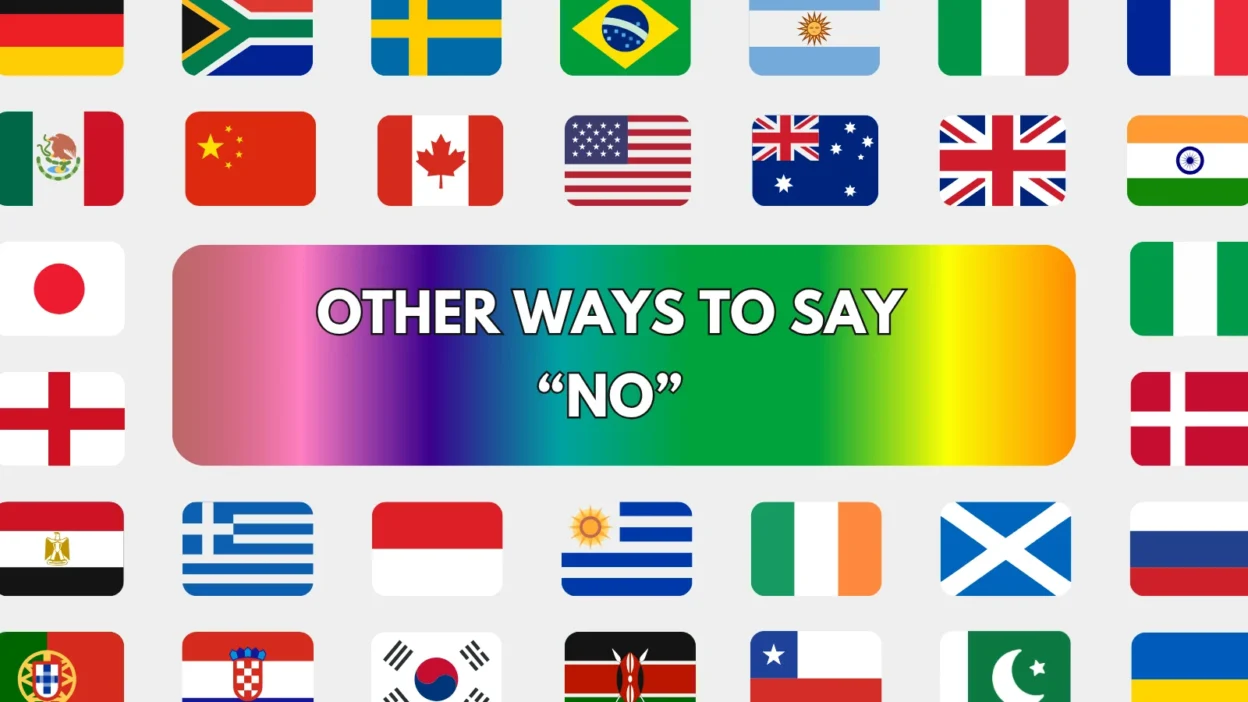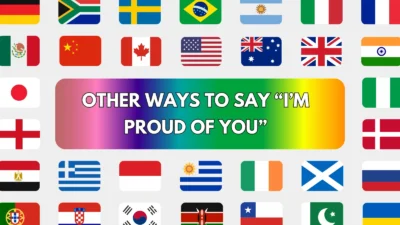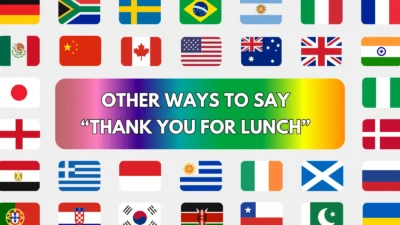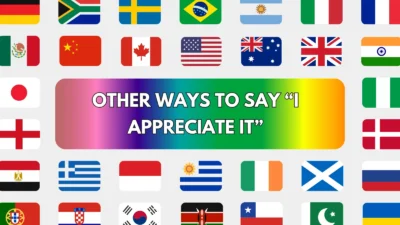Saying “No” is one of the most powerful tools in communication. Whether you’re setting boundaries, declining offers, or expressing disagreement, a clear “No” can save time and protect your well-being. But depending on the situation, tone, and relationship, a simple “No” might feel too harsh — or too soft.
That’s why having a variety of ways to say “No” helps you respond firmly, kindly, or professionally as needed. Below are 25 useful alternatives to say “No,” each with explanations and examples to help you choose the right tone every time.
1. No, thank you
Meaning:
A polite way to decline something.
Detailed Explanation:
This version softens the rejection by adding gratitude, making it ideal in casual or social settings.
Scenario Example:
Would you like more cake? No, thank you — I’m full.
Best Use:
Polite refusals, everyday conversations.
Tone:
Courteous, respectful.
2. I’m good
Meaning:
A casual way to decline something without sounding rude.
Detailed Explanation:
This phrase implies that you’re satisfied or not interested — often used when someone offers help or more of something.
Scenario Example:
Need help carrying that? I’m good, thanks!
Best Use:
Informal settings, peer conversations.
Tone:
Friendly, relaxed.
3. I’ll pass
Meaning:
A short, casual way to say no to an offer or invitation.
Detailed Explanation:
Sounds polite and non-confrontational, while clearly declining.
Scenario Example:
Want to join us for karaoke? I’ll pass tonight — feeling tired.
Best Use:
Social events, friendly settings.
Tone:
Casual, easygoing.
4. Not right now
Meaning:
A gentle way to delay or defer a request.
Detailed Explanation:
It doesn’t reject entirely but signals the current moment isn’t ideal.
Scenario Example:
Can we talk? Not right now — let’s connect after lunch.
Best Use:
Busy situations, respectful refusals.
Tone:
Polite, considerate.
5. I’m not interested
Meaning:
A direct way to show disinterest.
Detailed Explanation:
Firm but respectful, it helps avoid further pushback or follow-up.
Scenario Example:
Are you interested in this promotion? I’m not interested, thank you.
Best Use:
Sales, marketing calls, offers.
Tone:
Firm, straightforward.
6. Maybe another time
Meaning:
A soft “No” that suggests possible interest later.
Detailed Explanation:
Helpful when declining without closing the door completely.
Scenario Example:
Want to grab dinner tonight? Maybe another time — I’ve got a lot on.
Best Use:
Friendly invites, casual offers.
Tone:
Friendly, non-committal.
7. I’ll have to decline
Meaning:
A formal or polite way to say no.
Detailed Explanation:
Sounds professional and respectful, especially in business or formal invitations.
Scenario Example:
Thanks for the offer, but I’ll have to decline this time.
Best Use:
Work emails, formal replies.
Tone:
Polite, professional.
8. That won’t work for me
Meaning:
A clear refusal that explains incompatibility.
Detailed Explanation:
Helps set boundaries when plans or ideas don’t suit you.
Scenario Example:
Let’s meet at 7 a.m. tomorrow. That won’t work for me — can we do later?
Best Use:
Scheduling, negotiating plans.
Tone:
Direct, respectful.
9. I’m afraid I can’t
Meaning:
A soft way to express inability or refusal.
Detailed Explanation:
Using “I’m afraid” adds politeness and emotional softness to the rejection.
Scenario Example:
Can you join the meeting at noon? I’m afraid I can’t — I’m double booked.
Best Use:
Professional or formal contexts.
Tone:
Polite, empathetic.
10. Not possible
Meaning:
A clear and firm refusal.
Detailed Explanation:
Great when something truly cannot happen — short and final.
Scenario Example:
Can we move the deadline to tomorrow? Not possible — we need more time.
Best Use:
Firm professional settings.
Tone:
Assertive, clear.
11. No can do
Meaning:
A playful or casual way of saying no.
Detailed Explanation:
Often humorous, but still a firm refusal.
Scenario Example:
Can you work late again? Sorry, no can do — I’ve got plans.
Best Use:
Friendly workplace banter, informal talks.
Tone:
Lighthearted, fun.
12. Unfortunately, no
Meaning:
A soft rejection with a hint of regret.
Detailed Explanation:
The word “unfortunately” adds empathy to the denial.
Scenario Example:
Can you join the call today? Unfortunately, no — I have a conflict.
Best Use:
Professional settings, polite replies.
Tone:
Gentle, considerate.
13. I don’t think so
Meaning:
A hesitant or softer form of disagreement.
Detailed Explanation:
Can imply uncertainty or polite refusal.
Scenario Example:
Isn’t she coming too? I don’t think so — she didn’t mention it.
Best Use:
Everyday chats, mild disagreement.
Tone:
Soft, thoughtful.
14. I can’t commit to that
Meaning:
A respectful way to decline due to availability or uncertainty.
Detailed Explanation:
Signals that you value your time or don’t want to make false promises.
Scenario Example:
Can you join the committee? I can’t commit to that right now.
Best Use:
Work, volunteer requests, scheduling.
Tone:
Respectful, responsible.
15. I’m not able to
Meaning:
Expresses a lack of ability or time.
Detailed Explanation:
Less harsh than a plain “no,” while still declining.
Scenario Example:
Can you take this task? I’m not able to fit it in this week.
Best Use:
Work tasks, polite declines.
Tone:
Polite, explanatory.
16. That’s not an option for me
Meaning:
Clear rejection with personal boundaries.
Detailed Explanation:
Good for asserting limits without inviting argument.
Scenario Example:
Let’s meet at midnight. That’s not an option for me.
Best Use:
Boundary-setting, firm responses.
Tone:
Confident, assertive.
17. I’d rather not
Meaning:
A soft, personal way to say no.
Detailed Explanation:
Avoids sounding rude, while honestly expressing preference.
Scenario Example:
Want to speak in front of the group? I’d rather not, honestly.
Best Use:
Social situations, light decisions.
Tone:
Polite, personal.
18. Not today
Meaning:
A way to postpone or softly decline.
Detailed Explanation:
It gently says no while keeping the door open for another time.
Scenario Example:
Can we meet up? Not today — let’s talk later this week.
Best Use:
Friends, low-pressure settings.
Tone:
Casual, flexible.
19. That’s not for me
Meaning:
Expresses that something doesn’t suit your interests or style.
Detailed Explanation:
Useful when rejecting something based on preference rather than schedule.
Scenario Example:
Want to try skydiving? That’s not for me, but you go ahead!
Best Use:
Personal choices, polite refusals.
Tone:
Non-judgmental, easygoing.
20. I’d prefer not to
Meaning:
Shows personal reluctance politely.
Detailed Explanation:
Adds a tone of thoughtfulness, not abruptness.
Scenario Example:
Can you stay later? I’d prefer not to — I’ve got other plans.
Best Use:
Work, personal boundaries.
Tone:
Gentle, respectful.
21. Let’s not
Meaning:
Suggests mutual agreement in avoiding something.
Detailed Explanation:
Light and collaborative, but still firm.
Scenario Example:
Should we confront him now? Let’s not — it’s not the right time.
Best Use:
Team conversations, shared decisions.
Tone:
Soft, advisory.
22. I don’t feel comfortable with that
Meaning:
Communicates boundary or discomfort.
Detailed Explanation:
Empowering and respectful way to stand up for your values.
Scenario Example:
Let’s bend the rules a bit. I don’t feel comfortable with that.
Best Use:
Ethical boundaries, personal safety.
Tone:
Firm, thoughtful.
23. I wish I could, but I can’t
Meaning:
Polite refusal with an empathetic tone.
Detailed Explanation:
Acknowledges the request while staying honest.
Scenario Example:
Can you help this weekend? I wish I could, but I can’t — I’m out of town.
Best Use:
Friends, favors.
Tone:
Warm, apologetic.
24. I have to say no
Meaning:
A clear, responsible decision.
Detailed Explanation:
Firm, but adds accountability and thought.
Scenario Example:
Will you join the extra project? I have to say no — I’m at capacity.
Best Use:
Work, responsibility management.
Tone:
Assertive, respectful.
25. It’s a no from me
Meaning:
A direct and casual expression of refusal.
Detailed Explanation:
Popular in pop culture, it’s a simple but final way to say no.
Scenario Example:
Do you like this outfit for me? Hmm… it’s a no from me.
Best Use:
Casual conversations, personal opinions.
Tone:
Confident, casual.
Conclusion
Knowing how to say “No” in different ways lets you set boundaries confidently while staying kind and professional. Whether you’re declining casually, firmly, or with empathy, these 25 alternatives help you speak with clarity and care — no guilt attached.




